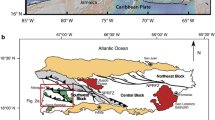Abstract
Small left-lateral strike-slip faults and right-lateral monoclinal kink bands with subvertical fold axes may be related to the formation of a very large right-lateral kink band (Bear Creek kink band), about 8 km wide and at least 15 km long, trending N27W along Bear Creek Valley in the Mt. Abbot quadrangle, Sierra Nevada, California.
A foliation within Bear Creek Valley is defined by vertical slabs of granodiorite bounded by joints and faults. Small strike-slip faults and larger fault zones have nucleated along preëxisting joints and accommodated shearing between granodiorite slabs. The orientations of small cracks that occur near the tips of faults or connect adjacent fault segments indicate that the direction of maximum compression was about 20° counterclockwise from traces of joints at the time the faults nucleated. In some places where faults are closely spaced there are small, right-lateral kink bands with widths of 1 to 20 m. The slabs of granodiorite are gently curved through the kink bands, and analysis of the orientations of slabs in the limbs of the small kink bands indicates that the direction of maximum compression during kink-band formation was 15° to 20° counterclockwise from the traces of faults outside the kink bands. The orientation of the maximum compression for the formation of the small cracks at tips of many strike-slip faults and for the formation of the small kink bands, relative to the orientation of the maximum compression inferred from the joints on the limb of Bear Creek kink band, suggests that the foliation within the Bear Creek Valley has reoriented a maximum of 40° to 60° clockwise. Although the various orientations of joints, faults, and kink bands could be explained in terms of different regional compression directions at different places and at different times in the Mt. Abbot quadrangle, a much simpler interpretation, based on analysis of large and small structures in the granodiorite in Bear Creek Valley, is that they all formed in response to one maximum regional compression in the direction N25E.
Similar content being viewed by others
References
Brace W. F. andBombolakis, E. G. (1963),A note on brittle crack growth in compression. J. Geophys. Res.68, 3709–3713.
Collier, M. (1978),Ultimate locking angles for conjugate and monoclinal kink bands. Tectonophys.48, T1–T6.
Donath, F. A. (1968), ‘The development of kink bands in brittle anisotropic rock,’ in L. H. Larsen (ed.),Igneous and Metamorphic Geology. Geol. Soc. Amer.Memoir 115, 453–493.
Gay, N. C. andWeiss, L. E. (1974),The relationship between principal stress directions and the geometry of kinks in foliated rocks. Tectonophys.21, 287–300.
Honea, E. andJohnson, A. M. (1976),Development of sinusoidal and kink folds in multilayers confined by rigid boundaries. Tectonophys.30, 197–239.
Johnson, A. M.,Physical Processes in Geology. Freeman, Cooper, San Francisco, Calif., 1970, p. 577.
Lockwood, J. P. andLydon, P. A. (1975),Geological Map of the Mount Abbot Quadrangle, Central Sierra Nevada, California. U.S. Geol. Surv. Quad. Map GQ-1155, scale 1∶62,500.
Lockwood, J. P. andMoore, G. (1979),Regional Deformation of the Sierra Nevada, California, on Conjugate Microfault Sets. J. Geophys. Res.84, 6041–6049.
Mayo, E. B. (1941),Deformation in the Interval Mt. Lyell — Mt. Whitney, California. Geol. Soc. Amer. Bull.52, 1001–1084.
Moore, G. (1963),Geology of the Mt. Pinchot Quadrangle, Southern Sierra Nevada, California. U.S. Geol. Surv. Bull.1130, p. 156.
Paterson, M. S. andWeiss, L. E. (1966),Experimental deformation and folding in phyllite. Geol. Soc. Amer. Bull.77, 343–374.
Reches, Z. andJohnson, A. M. (1976),Asymmetric folding and monoclinal kinking. Tectonophys.35, 295–334.
Segall, P. andPollard, D. D. (1980),Mechanics of discontinuous faults. J. Geophys. Res.85, 4337–4350.
Segall, P. andPollard, D. D. (1983a),Joint formation in granite rock of the Sierra Nevada. Geol. Soc. Amer. Bull.94, 563–575.
Segall, P. andPollard, D. D. (1983b),Nucleation and growth of strike slip faults in granite. J. Geophys. Res.88, 555–568.
Segall, P. andPollard, D. D. (1984),From joints and faults to photo-lineaments. Proc. Fourth Internat. Conf. Basement Tectonics, 11–20.
Author information
Authors and Affiliations
Rights and permissions
About this article
Cite this article
Davies, R.K., Pollard, D.D. Relations between left-lateral strike-slip faults and right-lateral monoclinal kink bands in granodiorite, Mt. Abbot quadrangle, Sierra Nevada, California. PAGEOPH 124, 177–201 (1986). https://doi.org/10.1007/BF00875725
Received:
Revised:
Accepted:
Issue Date:
DOI: https://doi.org/10.1007/BF00875725




